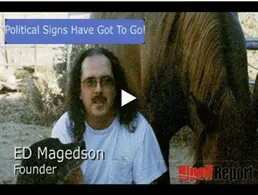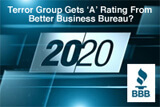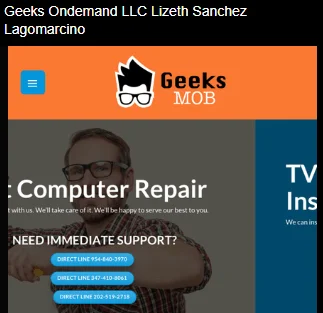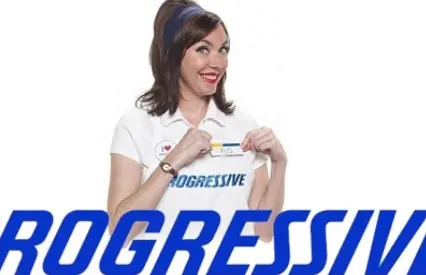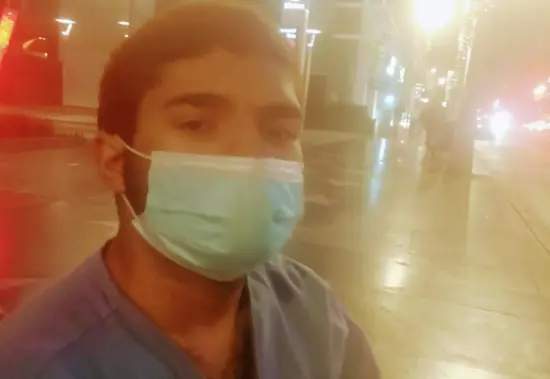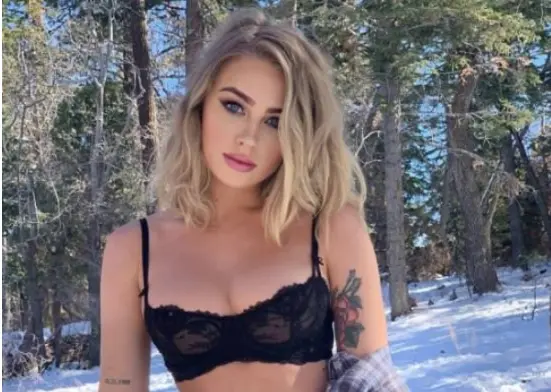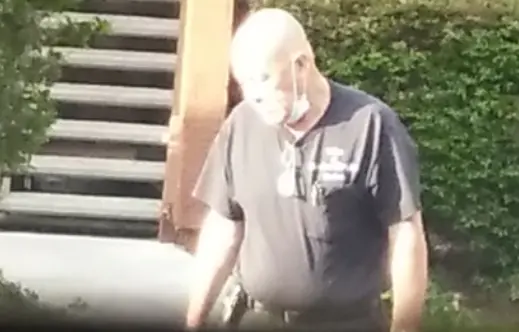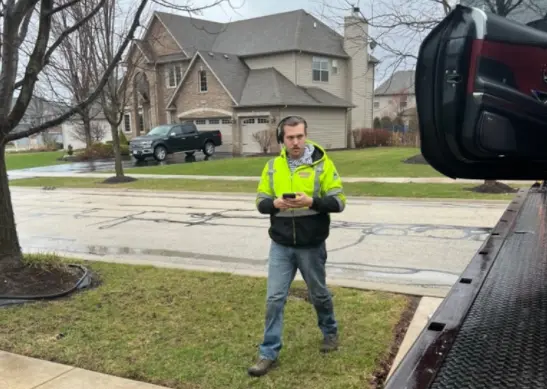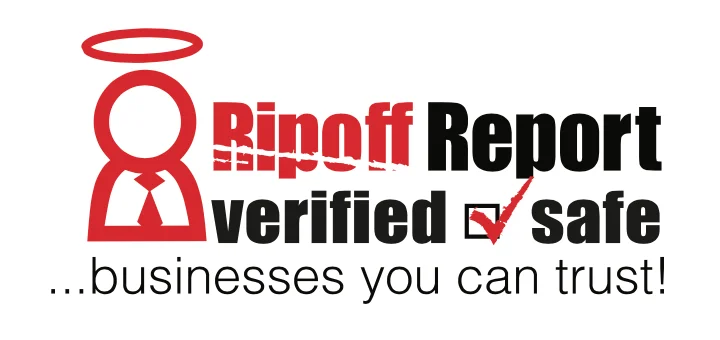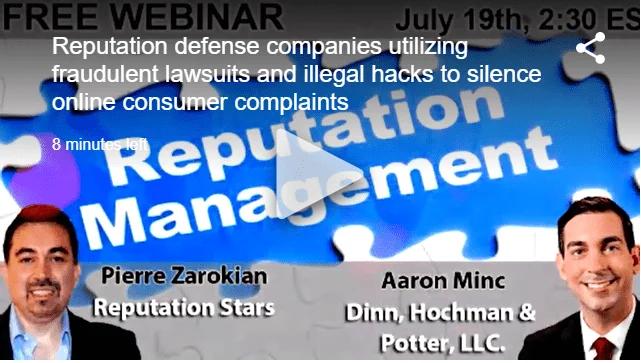Complaint Review: Al Gugglielmo - New York New York
- Al Gugglielmo http://www.talentproductionassociates.com New York, New York U.S.A.
- Phone: 212-
- Web:
- Category: Modeling Agencies
Al Gugglielmo ripoff Fake Talent Agent Defrauds prospecting models and entertainers into signing with him and has harassed people and used unauthorized photos on his site. What would be models need to know. New York New York
*UPDATE Employee: Its a top agency in nyc
*REBUTTAL Owner of company: al guglielmo is not fraud
*General Comment: ANOTHER FAILED AND DISGRUNTLED MODEL
*Author of original report: The Substantial Law On Model Releases
listed on other sites?
Those sites steal
Ripoff Report's
content.
We can get those
removed for you!
Find out more here.
Ripoff Report
willing to make a
commitment to
customer satisfaction
Click here now..
I've been online for 8 years in the entertainment industry and seen over 5200 industry sites and very few take the necessary precautions neccesary to work legit jobs.
The modeling & entertainment industry has changed drastically since the inception of the Internet
The reason why its so hard for the average model to make any good money or make something of themselves is due to a descrimination policy that most big agencies have.
You have to be 5 ft 10 and weigh 130 lbs When the majority of beautiful women and handsome men are under 5 ft 8 weighing at under 130 lbs
A PHOTOGRAPHER:
Not every website is "porn" and not every modeling picture is such either!
No, but Google and such engines have allowed the porn webmasters to use sexual epitaths in their meta tags to be combined with every day non sexual wording.
So when a non adult model or entertainer goes to enter modeling or acting, their going to get inundated with porn site links with the searches.
Domain name registrars have allowed porn people to buy names that are not indicators of porn.
PHOTOGRAPHER:
Having a safe and secure website is a great place to start!
There are ways to lock down a website so that it prevents people from copying by right clicking, or even keeping the "print" function spitting out blank pages so that nobody can even copy from a print.
Question:
As being a tech for 7 years
You have Windows?
Open Windows Explorer and open the Windows folder and then Internet Explorer Downloaded Files.
Those are pictures, graphics, videos of what has been automatically downloaded onto your hard drive when you browse a site.
So to say that you are protected from having your pics and videos safe in your server is wrong.
Because even though you may have those other blockers, you still can upload images to patrons computers.
So you can thank Bill Gates programming team for that
PHOTOGRAPHER:
The normal personal safety precautions apply with the Internet too. "Never give out your address or phone number to strangers,"
But most modeling sites that you visit, have this info
Plus, there are places and ways if experienced to locate other personal info through the server.
PHOTOGRAPHER:
A model I work with has had some guy sending her contracts that she asked me to look at.If she had signed these, she would have been in a world of hurt! I explained to her where she would be signing every right she had to any of her photos. The contract would have allowed them to put her face on porn sites even if she wasn't photographed under those circumstances.
He "IM"d me about her not responding to his offer. While he tried to throw smoke screens and mirrors at me, I shut him up right quick when I caught him in a lie with the first thing he had said about him being a "talent agent!" He wont bother us again!
MOST that you will see online are not licensed agents.
People think that just because they can create a site to help models, that they are qualified to be an agent for them.
Todays glamour girls and adult models use multiple "agents" to find jobs for them.
PHOTOGRAPHER:
Models and photographer should promote themselves in many different places to be successful.
With the way the spam laws are getting, that's going to be tougher.
Welcome to the new modeling industry !
I get this quite occasionally about someone getting scammed:
Anyone that has a dispute with anybody else concerning fraud or wrongful doing and has evidence, is best to not only bring it to the community but to places like ripoffreport.com , cyberangels, BBB, DA of their city or FBI if its bad and even the news or newspapers
And ask that your name be withdrawn from any public reports for your safety
They usually can set up a surveillance system to monitor their activities and whatever and investigate if they feel it is warranted
In the past it has been said that this is not a good thing to do, but if you have strong evidence that wrongful doing is occured or is occuring, then it is ethically and morally right for others to be warned so they don't get hurt. It is up to law enforcement to keep hot on the trail
Throughout the years I've heard many stories of scams going on and putting models in danger. And the model usually sits there scared but not willing to give up much info.
Everyone probably pretty much knows who Al Guglielmo is in NY. His scamming of models and entertainers and how I hear that the FBI is involved or had been involved.
Today 4-5 years later you can see that he's still at his old tricks and no one has shut this character down
http://www.talentproductionassociates.com
But what models and entertainers and such need to do is Pre-qualify their leads better than they have been.
Most issues would be prevented if such procedures occured and you would feel more secure about the job and person
WHO, WHAT, WHERE, WHEN, HOW AND REFERENCES
You also should know that just because there's a few sour apples in the tree, doesn't mean the whole tree is infested. So don't go throwing insults and insinuations if you can't back them up
It's a numbers game and you have to just go on and market yourself and keep positive.
That's why I stongly feel that there is no such thing as competition when it comes to photographers and producers, magazines, etc.
Because everyone is different. They have different needs and wants and the next week or month they may choose you because you have the look they desire.
One photographer may not want you, but another may
But if you don't stick your head out and just create a site, you're not going to get the full potential of your abilities out there that you may have to offer.
The more agencies/businesses/leads you reach, the better your odds of making a deal
And telling your fans to tell the photographer or producer or magazine that they recommend you wouldn't hurt as that shows that you have a strong support group.
And be creative and unique with shoots and your sites
Everyone is unique in their own way. It all depends on your attitude, your appearance, the place of business' needs and how far you are willing to go to get yourself known
That will bring more of you out to interest others.
Of course, people who are physically fit and look glamorous and who might have a better background as you, and will most likely get first dibs, but so do the other people, depending on the clients needs.
Players and Winners
and
Fakers and Losers
No matter your choice, you will be classified.
Do the right thing and go with someone strong who can guide you away from the mud
SCHMOOZE!!
Be Flexible
Be determined
Focus forward towards your goal
Think in your mind "I will succeed" 10 times a day
Be Goal oriented
Stay away from trouble
Hang around positive people
Learn from others mistakes
Cultivate your career by staying in shape, eating right, sleeping right, and learning right
Think of problems and put downs as obstacles or issues and not problems, and focus on getting around those obstacles/issues.
Improve your education
Push yourself to the limit but not too far that you lose your concentration Spread your options (example, if you do lingerie at 18yrs+, get into nude & glamour modeling-there's high demand for those, and you already are just about nude, so why not?, etc.)
Nudity Shoots are not a bad thing to get ivolved in
There's too many hang ups in America and it is your duty to break peoples stereotypes and misconceptions
STUDY ALL YOU CAN ABOUT THE SUCCESSFUL PEOPLE THAT HAVE REACHED THE TOP, AND SEE WHAT QUALITIES THEY HAVE THAT YOU MIGHT BE ABLE TO USE.
Learn something about sales and business and law.
IT MIGHT HELP YOU IN THE LONG RUN.
Learn everything you can about modeling.
Look at yourself in the mirror and see how you feel--
If you feel uncomfortable, ask yourself
"How can I get more comfortable",
"How can I break this pattern of uneasement with my body"
If you feel that you need or want cosmetic surgery--
ALWAYS GET A SECOND OPINION
MOST IMPORTANT OF ALL--THINK IN YOUR MIND
"I WILL BE ONE OF THE BEST ____________ INTERNET SUPER MODELS IN THE COUNTRY"
If you say that enough times in your life, you will train your mind to become one of the best ___________ Internet Super Models in the country.
THE WORST THING YOU CAN DO IS--
BREAK DOWN IF YOU DIDN'T BECOME A GREAT MODEL BY OTHER'S EYES, BECAUSE EVERYONE HAS DIFFERENT TASTES AND EVERYONE HAS DIFFERENT MOODS FOR CERTAIN DAYS.
One method I use a lot is:
If I run into an obstacle, I take the mental image of that obstacle and make the image smaller, change the characteristics, the colors, and the sizes of the people...WHY?
Say, let's bring cooking into the scenario--
You get a pot of water and you put the heat on MED.
WHAT HAPPENS TO THE WATER IS THAT IT COULD TAKE AN HR OR MORE TILL YOU SEE BUBBLES OR BOILING.
If you turn the temperature up to HIGH.
THEN YOU SEE THAT IT TAKES A FEW MINUTES TILL IT REACHES IT'S BOILING POINT WITH ITS INTENSITY.
Now with using that theory, I explain to you that
If you take that mental image of yours and turn it on High, then the emotional intensity of that image will intensify and you will get real upset instead of concentrating on why you got into that problem and how you can resolve it and/or emotion, or loss of a modeling job.
If you take that same image and put it on Low
What you begin to feel is the emotion of the problem isn't so intense or bad and it gives you a clearer mind.
Modeling agencies are looking for young females and males who first and foremost have the "LOOK".
Agencies are somewhat less interested in modeling candidates who have the right look but not much else to offer.
Modeling is a very visible career and successful super models must be able to communicate effectively in public speaking venues.
College classes and training in speech and communications can improve the value of your offering considerably. Enter into helpful organizations and get involved in your community, volunteer work.
Remember that the competition for the limited supply of modeling jobs is fierce and COMPETITIVE on a worldwide scale, but the competition is really about you and not them
Accept no's and turn them into yesses.
See how you can become better.
Do not get anorexic...THAT IS PATHETIC.
Try to be proportionate to your body, weight, and height...
Don't be 5'11" and weigh 110 lbs.
Stay healthy-eat the right foods, drink the right drinks, exercise at least every other day, don't smoke and if you do, try to quit.
So if you are truly willing to give in 110% of a commitment, you have some thinking, planning, and implementing to do
ALWAYS LOOK UP AND FIGHT THE NEGATIVITY.
EVENTUALLY THE POSITIVITY WITHIN YOUR SOUL WILL EAT UP THE NEGATIVITY
READ YOUR CONTRACTS AT THE FINE PRINT
Do these things I have told you and you will become better than you ever thought previously
If you are not sure of someone or something, you can always ask a professional or Tracey Walker or Cyberangels, or the Better Business Bureau
Consumer Federation of America
National Fraud Information Center
Office of Consumer Affairs
Department of Motor Vehicles
State Bar
http://directory.google.com/Top/Society/Law/Law_Enforcement/
http://www.findlaw.com
http://www.firstgov.gov/featured/usgresponse.html
http://www.hsh.com/pamphlets/cons_protect.html
http://www.uslaw.com/library/article/article_338.html?area_id=7
http://www.pueblo.gsa.gov/specialstuff/bluepage/america5.htm
The thing I stress to models and entertainers is to diversify their image. You don't stick with 1 thing and think you're going to succeed. You do a variety of things to back yourself up
Al
Lv, Nevada
U.S.A.
This report was posted on Ripoff Report on 02/08/2004 06:20 PM and is a permanent record located here: https://www.ripoffreport.com/reports/al-gugglielmo/new-york-new-york/al-gugglielmo-ripoff-fake-talent-agent-defrauds-prospecting-models-and-entertainers-into-s-79697. The posting time indicated is Arizona local time. Arizona does not observe daylight savings so the post time may be Mountain or Pacific depending on the time of year. Ripoff Report has an exclusive license to this report. It may not be copied without the written permission of Ripoff Report. READ: Foreign websites steal our content
If you would like to see more Rip-off Reports on this company/individual, search here:
#4 UPDATE Employee
Its a top agency in nyc
AUTHOR: al guglielmo.....talentproductions - (USA)
SUBMITTED: Monday, March 14, 2011
Shelly Rivington
Here are a few letters I have read concerning Al.... It's amazing at how much bad someone can say about someone they have never even met or they didnt get a job from the person so they decide to SLANDER the individual... but hey don't take my word for it all read what others did have to say.
Write a comment...
Press Shift+Enter to start a new line.
Remove Post
Al Guglielmo My Trip
SAYIN THANK YOU TO AL G. OF TALENT PRODUCTION FOR A WONDERFUL TIME IN NEW YORK. HE IS VERY PROFESSIONAL AT WHAT HE DOES. HE WORKED VERY HARD TO GET ME THE OPPORTUNITIES THAT I NOW HAVE IN MODELING AND ALSO ACTING. ACCOMADATIONS WERE GREATLY APPRECIATED. AND THE PEOPLE I... GOT TO MEET WERE AMAZING. THANK YOU AGA...IN FOR THE TREMENDOUS JOB YOU HAVE DONE AND WILL CONTINUE TO DO FOR ME...... MS T
#3 REBUTTAL Owner of company
al guglielmo is not fraud
AUTHOR: al guglielmo.....talentproductions - (USA)
SUBMITTED: Monday, March 14, 2011
Here are a few letters I have read concerning Al.... It's amazing at how much bad someone can say about someone they have never even met or they didnt get a job from the person so they decide to SLANDER the individual... but hey don't take my word for it all read what others did have to say.
a post from nadia about aL
hey just wanted to say hi and that i was just thinking about how really wonderful you are and that you need to be told and i bet that not everyday you hear that, but im telling you today that you tuely are so great and kind, truthful ,respectf...ul, careing and thoughtful and the list goes on ...and on. i mean that from the heart you are my angel sent from heaven. ... i truely want to say that it is my pleasure to work with you and that you have given me something that i will always cherish, A CHANCE thank you so much for believing in me and for trusting me and for makin my dreams come true.what else could i ask for you my dear will be rewared for being such a wonderful and real man. all you ladies there are not enough words to describe how great he really is. it is what it is. you al are the best friend anyone could ever have really.now i know why so many wonderful people love you,you are always there for people and always looking out for others
My Trip
SAYIN THANK YOU TO AL G. OF TALENT PRODUCTION FOR A WONDERFUL TIME IN NEW YORK. HE IS VERY PROFESSIONAL AT WHAT HE DOES. HE WORKED VERY HARD TO GET ME THE OPPORTUNITIES THAT I NOW HAVE IN MODELING AND ALSO ACTING. ACCOMADATIONS WERE GREATLY APPRECIATED. AND THE PEOPLE I... GOT TO MEET WERE AMAZING. THANK YOU AGA...IN FOR THE TREMENDOUS JOB YOU HAVE DONE AND WILL CONTINUE TO DO FOR ME...... MS T
Write a comment...
Press Shift+Enter to start a new line.
Remove Post
Al Guglielmo My Trip
SAYIN THANK YOU TO AL G. OF TALENT PRODUCTION FOR A WONDERFUL TIME IN NEW YORK. HE IS VERY PROFESSIONAL AT WHAT HE DOES. HE WORKED VERY HARD TO GET ME THE OPPORTUNITIES THAT I NOW HAVE IN MODELING AND ALSO ACTING. ACCOMADATIONS WERE GREATLY APPRECIATED. AND THE PEOPLE I... GOT TO MEET WERE AMAZING. THANK YOU AGA...IN FOR THE TREMENDOUS JOB YOU HAVE DONE AND WILL CONTINUE TO DO FOR ME...... MS T
See More
March 9 at 11:31pm ·LikeUnlike ·
Write a comment...
Press Shift+Enter to start a new line.
Remove Post
Al Guglielmo a post from nadia about aL
hey just wanted to say hi and that i was just thinking about how really wonderful you are and that you need to be told and i bet that not everyday you hear that, but im telling you today that you tuely are so great and kind, truthful ,respectf...ul, careing and thoughtful and the list goes on ...and on. i mean that from the heart you are my angel sent from heaven. ... i truely want to say that it is my pleasure to work with you and that you have given me something that i will always cherish, A CHANCE thank you so much for believing in me and for trusting me and for makin my dreams come true.what else could i ask for you my dear will be rewared for being such a wonderful and real man. all you ladies there are not enough words to describe how great he really is. it is what it is. you al are the best friend anyone could ever have really.now i know why so many wonderful people love you,you are always there for people and always looking out for others
#2 General Comment
ANOTHER FAILED AND DISGRUNTLED MODEL
AUTHOR: Jack - (United States of America)
SUBMITTED: Tuesday, February 23, 2010
Your rambling statement makes you sound like a disgruntled wannabe model, who failed in the industry. Have you considered seeking professional psychiatric treatment?
#1 Author of original report
The Substantial Law On Model Releases
AUTHOR: Al - (U.S.A.)
SUBMITTED: Sunday, February 08, 2004
When it comes to legal matters, it is never enough to merely be "right."
Being right may still cost many thousands of dollars to prove in court.
You will be in a much better position if you can avoid the expense of litigation in the first place.
A thorough understanding of model releases involves knowing the law that gave rise to them.
Only when you know why they are needed can you know when they are needed.
Application of this knowledge may, in turn, head off the cost of litigation by making photographers, subjects/models, and publishers more keenly aware of each party's respective rights and duties.
This letter addresses the following questions:
I. What purpose does a model release serve?
II. Who should be concerned with the rights and liabilities concerning model releases?
III. When are model releases necessary?
IV. Why are model releases necessary?
A. Right of Privacy
1. Privacy - A Personal Right?
2. Statute of Limitations
3. Four Distinct Branches
a. Intrusion upon Plaintiff's Seclusion or Solitude or into his Private Affairs
b. Publication of Private Facts
c. False Light
d. Commercial Appropriation / Misappropriation of Name or Likeness
V. What exceptions are there to the general rule?
A. Public Figures
B. Newsworthy Events
VI. Model Releases and Contract Concerns.
A. Bargained-For Consideration
B. Minors and Model Releases
C. Parol Evidence Rule, Application of
D. Terms
1. Purpose of Use
2. Nature of Use
3. Duration of Use
I. Model Releases: What do they do?
According to an article by Steven Lundberg, a model release is used "to obtain authority from an individual or his or her company to use that individual or his or her company's name, voice, visual likeness, quotes, photographs, or music, and so on." (Steven Lundberg, Multimedia Legal Issues, http://www.slwk.com/paper4.html )
Additionally, model releases may be used "to have the individual or company warrant that they have the authority to provide the appropriate release." Ibid.
II. Model Releases: Who should be concerned with them?
Obviously, photographers and models should familiarize themselves with the law behind model releases.
However, photographers and models are far from the only people who must concern themselves with this information.
Indeed, professional photographers shooting professional models may have less liability to worry about than others do.
Often, litigation of model releases involves the publishers and producers of media in all its forms - advertisements, magazines, newspapers, films, television programs, and web sites, to name only a few.
Anyone who deals in the likenesses of others should be informed of the laws behind model releases.
Wise media publishers should know when they will need releases and will seek to protect themselves from litigation.
They do this by requiring photographers to produce valid model releases before compensating the photographer for the photos.
Therefore a photographer generally needs to provide publishers with a valid model release in order for her work to have any commercial value.
In other words, no release = no sale.
This is particularly true when dealing with stock photography outfits whose business revolves around the licensing and reselling of photographs and video footage.
III. Model Releases: When are they Necessary?
A court deciding a case against Hustler magazine summed up the answer to this question when it stated:
"Any person who knowingly uses another?s name, photograph, or likeness ... without such person's prior consent, or in the case of a minor, the consent of his parent or legal guardian, shall be liable for any damages sustained by the person or persons injured as a result thereof . . . ."
- Faloona v Hustler Magazine, Inc., 607 F Supp 1341, (1985, ND Tex).
IV. Model Releases: Why are they Necessary?
A. Right of Privacy - Background and Significant Issues
The right of privacy has been described as "the right to be left alone." W.P. Keeton, D. Dobbs, R. Keeton, & D. Owen, Prosser and Keeton on the Law of Torts, Sec. 117 at 864 (5th ed. 1984).
While not explicit in the constitution, the right of privacy grew out of "natural law" and was first expressed as a distinct right in a law review article written entitled "The Right to Privacy" by Warren and Brandeis.
Warren and Brandeis, The Right to Privacy, 4 Harv.L.Rev. 193 (1890).
Before Warren and Brandeis tackled the issue, the "right of privacy" found protection under the umbrellas of contract, property, and other conventional areas of law.
Familiarity with the right to privacy is important because a distinct right of privacy is now recognized, either as a common-law right or by statute, in at least 35 states.
Fortas, J., dissenting in Time, Inc. v Hill (1967) 385 US 374, 413, 17 L Ed 456, 481, 87 S Ct 534.
1. Privacy - A Personal Right?:
The right to privacy is generally referred to as a personal right.
In other words, an action could not be brought on someone else's behalf but must be brought by the person who suffered the unwarranted publicity.
A plaintiff in a right of privacy case must have had his or her own privacy right invaded.
However, courts are split on the issue of whether a relative or other survivor may bring a claim for invasion of privacy on behalf a deceased relative. A case from New York held that the State's privacy statute does not protect the name or likeness of a deceased person as the deceased no longer has a right of privacy to invade.
Lunceford v. Wilcox, 88 NYS2d 225 (1949).
While the dead may not have a right to privacy and their relatives may or may not be entitled to bring suit on their behalf, this is little consolation to the media publisher seeking extensive circulation of their material.
An advertisement that is not actionable in one jurisdiction may very well be actionable in another.
Therefore consideration of the publication's market would be important.
An advertisement intended for purely local distribution depicting a deceased "John Doe" may pose little trouble in New York.
However, a similar advertisement in a national publication may give rise to a cause of action in any jurisdiction which does honor a posthumous right of privacy because the harm arguably occurred there.
Meaning it would be a mistake to limit your concern to the jurisdiction in which the deceased lived.
Further, while a relative or survivor may not be able to bring suit on behalf of the deceased, the nature of the publication may allow the relatives or survivors to bring suit in their own right for an invasion of privacy.
In an Alabama decision, a court found there to be no reason why the right of privacy of daughters could not be violated by unwarranted and offensive publicity with reference to their deceased father.
Smith v. Doss, 251 Ala 250, 37 So2d 118, (1948).
All things considered, photographers and publishers put themselves at risk even when using the unauthorized likeness of a dead person and should consider the risk before proceeding.
When in doubt, it would probably be best to seek authorization from the survivors and/or estate of the deceased when feasible to do so.
Also, consider the nature of the publication and the context in which the deceased's likeness will appear.
Warranted and inoffensive publicity differs greatly from "unwarranted and offensive publicity."
2. Statute of Limitations:
Another important issue to consider is the statute of limitations on a claim for invasion of privacy.
Here again, there is no easy, unified answer. State statutes vary on the length of time allowed for a plaintiff to bring a tort action, such as a claim for invasion of the right of privacy, before their complaint is barred.
Statutes of limitations vary from one to six years for tort actions "depending upon the way the statutes and the courts view the nature of a cause of action for invasion of the right of privacy." Annotation Limitation of Actions:
Invasion of Right of Privacy, 33 A.L.R.4th 479, (1996).
The statute of limitations may begin to run at the time of the invasion of privacy or it may begin at the time the plaintiff discovered the invasion (or could have reasonably discovered the invasion through due diligence).
In some cases, the statute of limitations may not begin to run (the statute is "tolled") when the plaintiff's discovery of the invasion is delayed by fraudulent concealment.
Because of this variance, it is once again important to make decisions in light of the market of the publication and the jurisdictions that the publication will be exposed to.
3. Four Distinct Branches:
The right of privacy evolved over time and divided into four distinct branches:
Intrusion upon Plaintiff's Seclusion or Solitude or into his Private Affairs;
Publication of Private Facts;
False Light; and
Commercial Appropriation / Misappropriation of Name and Likeness.
"The most prominent proponent of this analysis having been Dean William Prosser, see Prosser, Law of Torts Sec. 117 (4th Ed. 1971) and Prosser, Privacy, 48 Calif L. Rev. 383 (1960), whose position as reporter allowed his view to be incorporated into the current substitute for the general common law, the American Law Institute's Restatements, see Restatement (Second) of Torts Secs. 652 A - I (1977)." Easter Seal Soc. v. Playboy Enterprises, 530 So. 2d 643 (1988).
a. Intrusion upon Plaintiff's Seclusion or Solitude or into his Private Affairs
According to Section 652B of Tentative Draft No. 13 (1967) of the Restatement 2d of Torts:
"One who intentionally intrudes, physically or otherwise, upon the solitude or seclusion of another, or his private affairs or concerns, is subject to liability to the other for invasion of his privacy if the intrusion would be highly offensive to a reasonable man."
This is the first of the four distinct causes of action under the umbrella of the right of privacy.
At first blush, one might assume that this cause of action would be limited to stealthy photographs taken through shrubbery with lengthy telephoto lenses.
While such an intrusion could fall under this branch of the right of privacy, this example remains far from the whole story.
You will find an typical example of a case trying this tort action in Miller v National Broadcasting Co..
Here the court considered a case involving a television camera crew.
The camera crew had accompanied an emergency medical team to a couple's home on an emergency call to assist a heart attack victim.
Without requesting or obtaining permission, the camera crew entered the victim's apartment with the EMTs and shot video of the team rendering aid to the victim. Though the trial court granted summary judgment in favor of the news media, the appellate court reversed and found that the widow of the heart attack victim had indeed stated a cause of action for intrusion into her private affairs.
The appellate court labled the camera crew's actions "highly offensive conduct" and allowed the widow's case to be determined by a jury.
In many cases alleging intrusion upon an individual's solitude or seclusion, the plaintiff's case is lost when the defendant shows the plaintiff had no reasonable expectation of privacy and / or when the plaintiff fails to show that the defendant's alleged intrusion was highly offensive to a reasonable person.
In De Lury v Kretchmer, sanitation workers complained of being required by their employer to have their pictures taken.
Their employer took the photographs to determine which employees were unlawfully collecting refuse from businesses for money.
The court found that there was no intrusion upon the plaintiffs' seclusion or solitude because the pictures were taken during normal business hours and there was no detention of the plaintiffs.
De Lury v Kretchmer, 322 NYS2d 517, (1971).
Another intrusion case dealt with a doctor who photographed a dying patient without the patient's consent and despite the patient's objections.
The court allowed the dying patient's widow to pursue the cause of action on her deceased husband's behalf even though the doctor used the photos solely as part of the patient's own medical record.
The court acknowledged the doctor's claims that the photos would be useful for dealing with similarly afflicted patients in the future.
However, the court answered, only the patient had the right to determine whether his picture would be taken. Estate of Berthiaume v Pratt (1976, Me) 365 A2d 792, 86 ALR3d 365.
In a similar case, Clayman v Bernstein, 38 Pa D & C 543, (1940), a doctor took photographs of a patient while the patient was semi-concious.
This court likewise found in favor of the plaintiff patient.
The doctor claimed that an invasion of privacy was not present without publication of the photos or other improper use but the court disagreed.
The court stated:
that an individual has the right to decide whether that which is his shall be given to the public and not only to restrict and limit but also to withhold absolutely his talents, property, or other subjects of the right of privacy from all dissemination, that the facial characteristics or peculiar cast of one's features, whether normal or distorted, belong to the individual and could not be reproduced without his permission, that even the photographer who was authorized to take a portrait was not justified in making or retaining additional copies for himself, and that unlike the law of libel which required publication to a second person, one's right to privacy could be invaded by a single human agency.
The court explained that the patient's right to decide whether her facial characteristics should be recorded for another's benefit or by reason of another's capriciousness had been violated, that the scope of the authorization defined the extent of the acts necessary to constitute a violation, if the patient had consented to have her photograph taken only for the doctor's private files certainly he would have had no right to exhibit it to others without her permission, so, the court queried, could it be said that his rights were equally extensive when even that limited consent had not been given? Moreover, the court continued, if the film had been developed by one other than the doctor himself, even though the negative had not been printed, the mere development would constitute publication even if the established standards of the laws of libel were adopted, and the taking of the photograph for the purported purpose of establishing a medical record gave rise to a presumptive intent not only to develop the film but to print the negative and exhibit the print.
In rejecting the argument that a physician was privileged to take photographs of his private patients without their consent as part of his medical record, the court said that it might be conceded that to an extent there was an implied waiver of the right of privacy in the relationship of physician and patient, but that there could never be a waiver, either expressed or implied, of any right without knowledge and consent and any such waiver was limited thereby.
Phillip E. Hassman, J.D., 86 A.L.R.3d 374, (1996).
b. Publication of Private Facts
Under the Restatement (Second) of Torts, Section 652(d), the tort of Publication of Private Facts is defined as:
"One who gives publicity to a matter concerning the private life of another is subject to liability to the other for invasion of his privacy, if the matter publicized is of a kind that
(a) would be highly offensive to a reasonable person, and
(b) is not of legitimate concern to the public."
This right of privacy tort obviously applies only to private facts. There is no "liability when the defendant merely gives further publicity to information about the plaintiff which is already public" or where the publicity involves matters that "the plaintiff himself leaves open to the public eye."
Restatement (Second) of Torts @ 652D, comment c.
The point made above is embraced in Faloona v. Hustler, 607 F. Supp. 1341, (1985, ND Tex).
In Faloona, a mother had allowed nude pictures to be taken of her minor children and signed a release on her childrens' behalf.
The pictures were published in a quasi-scientific book The Sex Atlas.
The mother, however, brought suit against Hustler magazine when she discovered that some of the pictures taken for use in The Sex Atlas appeared in a book review in Hustler.
She and her children found the publication to be offensive and didn't appreciate being associated with the magazine.
The Faloonas sued under the right to privacy causes of action of false light, commercial appropriation, and publication of private facts.
The publication of private facts claim was based on the disclosure of the "highly private facts of their nude appearance."
While acknowledging the plaintiffs' disgust at the publication of their photos in Hustler, the court found the private facts claim to be baseless.
By signing the release and consenting to the publication of the nude photographs in The Sex Atlas, the court reasoned that the Faloonas' nude appearance was anything but a private fact. Additionally, the court placed great weight upon the form of the model release used here.
There were no restrictions placed upon the future use of the pictures or the context in which they were allowed to appear.
Further, the facts of the case showed that the plaintiffs were quite proud of the pictures and displayed them in their home so that all visitors could view them. Under the circumstances, the court could not be convinced that the plaintiffs' appearance in the nude was a private fact upon which the Faloonas could sue.
Faloona v. Hustler, 607 F. Supp. 1341, (1985, ND Tex).
c. False Light (placing the plaintiff in ?)
Under the Restatement (Second) of Torts, Section 652(e), the tort of False Light is defined as:
"One who gives publicity to a matter concerning another that places the other before the public in a false light is subject to liability to the other for invasion of his privacy, if
(a) the false light in which the other was placed would be highly offensive to a reasonable person, and
(b) the actor had knowledge of or acted in reckless disregard as to the falsity of the publicized matter and the false light in which the other would be placed."
A leading case dealing with photography and the tort of false light can be found in Wood v. Hustler Magazine, 736 F2d 1084, (1984, CA5 Tex).
A housewife, LaJuan Wood, brought this lawsuit against Hustler magazine after the magazine published nude photographs of her.
The photographs had been stolen by a neighbor and sent in to the magazine along with a forged consent form. The court determined that Hustler had been negligent in administering its "questionable procedure" for verifying submissions and applied a negligence standard to the false-light claim.
Regarding the false light claim, the court stated, "Under the false light theory, Hustler's publication falsely represented that LaJuan consented to the submission and publication in a coarse and sex-centered magazine of a photograph depicting her in the nude.
Moreover, the publication falsely attributed a lewd fantasy to LaJuan.
Under public disclosure of private facts, Hustler gave publicity to the highly private fact of LaJuan's nude appearance, the publication of which, absent her consent, would be highly offensive to a reasonable person and was not of legitimate public concern." Wood v. Hustler Magazine, at 1089.
Another leading false light case can be found in Braun v. Flynt, 726 F.2d 245, 252 (5th Cir. 1984):
In Braun, a photograph of plaintiff appeared in Chic magazine, described by the court as a "glossy, oversized, hard-core men's magazine" devoted exclusively to sexual exploitation and to disparagement of women.
She appeared individually, with her co-worker "Ralph the Diving Pig", and was highlighted in a section of the magazine entitled "Chic Thrills." Arguing that the entire magazine should be considered as the context in which her photograph appeared, plaintiff argued that an ordinary reader automatically will form an unfavorable opinion about the character of a woman whose picture appears in Chic magazine.
The court added that even if an ordinary reader might not presume plaintiff to be unchaste or promiscuous, he might presume that she consented to appear in the magazine and approved of the opinions expressed therein. Easter Seal Society v. Playboy Enterprises, 530 So. 2d 643, (1988).
d. Commercial Appropriation / Misappropriation of Name or Likeness
The Restatement (Second) of Torts, Section 652(c), defines the tort of commercial appropriation / misappropriation of name or likeness as:
"One who appropriates to his own use or benefit the name or likeness of another is subject to liability to the other for invasion of privacy."
The Faloona v. Hustler case addressed under the publication of private facts heading also claimed an invasion of their right to privacy through the commercial appropriation cause of action.
To this claim, the court had several responses. First, the court observed that "mere publication of a person's likeness in a commercial newspaper or magazine does not create a cause of action for misappropriation.
The public must be able to identify the person from the photograph or drawing -- and the defendant must have capitalized upon the likeness of that person in order to sell more magazines or newspapers." The court found it to be significant that Hustler did not identify the plaintiffs in any manner.
Their names were not listed in any caption alongside the pictures.
Furthermore, Hustler did not publicize the magazine issue based on the pictures of the plaintiffs: "Hustler did not exploit the photographs in a publicity campaign designed to sell more magazines. Indeed, the "preview" in the November 1978 issue for the coming excerpt from The Sex Atlas uses a nude picture of other children, not the plaintiffs."
Faloona v. Hustler, 607 F. Supp. 1341 at 1360, (1985, ND Tex).
The existence of a model release is of particular significance to a claim for commercial appropriation as "a signed release is an affirmative defense to the tort of misappropriation."
Kimbrough v. Coca-Cola USA, 521 S.W.2d 719 (Tex. Civ. App.--Eastland 1975, writ ref'd n.r.e.).
Further, the safekeeping of model releases is extremely important.
If a publisher or photographer cannot produce a signed release (due to loss or destruction, for example), it is up to the trier of fact to determine the credibility of the witnesses and to decide whether a signed release existed or not.
Asylum Enterprises, Inc. v. Michael McIntyre, 1988 Tex. App. 814, (1988).
V. What exceptions are there to the general rule?
The First Amendment to the Constitution tempers the extensive protections afforded by the right of privacy.
Two leading cases addressing this point are Huskey v National Broadcasting Co., (1986, ND Ill), 632 F Supp 1282 and Time, Inc. v. Hill, 385 U.S. 374, (1976). The Cassidy case deals with the privacy limitations on public figures whereas the Time, Inc. case deals with the right to cover newsworthy events.
A. Public Figures
An annotation by Edward L. Raymond, Jr., J.D. discussed the limitations to the right of privacy of public figures. Looking at Huskey v National Broadcasting Co., the annotation observed:
"It is a well-settled principle that the right of privacy does not prohibit the publication of matter which is of legitimate public interest, such as information about a public official or public figure.
And, since it is recognized that a public official or public figure cannot complain when he or she is photographed or filmed in connection with a legitimate news story, the news medias have attempted to use the subject's status as a public figure or public official as a defense to a charge that they intruded into the subject's seclusion in the course of their news-gathering.
One court which has considered the issue has ruled that since a policeman is a public official, the plaintiff could not recover for an alleged intrusion upon his seclusion by a television crew which videotaped him undercover at a massage parlor, since his status as a public official was tantamount to an implied consent to be videotaped."
Intrusion by News-Gathering Entity as Invasion of Right of Privacy, Edward L. Raymond, Jr., J.D, 69 A.L.R.4th 1059.
The annotation also analyzed the right of privacy of a prisoner in Huskey v National Broadcasting Co.:
The court in the following intrusion upon seclusion case held that a television network had failed to show that a prison inmate was a limited purpose public figure and that its filming was consistent with the limitation on his public figure status.
Ruling on a motion to dismiss an invasion of privacy action brought by a prison inmate who was filmed by a television news crew without his permission while he was exercising in a prison exercise cage, the court in Huskey v National Broadcasting Co. (1986, ND Ill) 632 F Supp 1282, 12 Media L R 2105 (applying Illinois law), held that the television network had failed to show that the prisoner was a limited purpose public figure with a very limited and narrow expectation of privacy and that its filming of the prisoner was consistent with the admitted limitation on his public figure status. Recognizing that criminals may not stave off public reportage of matters associated with a completely publicized crime, the court ruled that the extent of public curiosity about criminals was bound up with a degree of publicity and the nature of the facts that made a particular criminal a public figure in the first place.
Finding that the network did not suggest that the film might seriously throw some light upon the kind of person the inmate was, his possible guilt or innocence, or his reasons for committing a crime, all of which would be matters of legitimate public interest, the court concluded that the record did not suggest any reason why anything more than morbid and sensational prying would justify filming the inmate's activities in the exercise cage.
Additionally, the court rejected the network's argument that the legitimate public stake in prison conditions blocked the inmate's action.
Noting that the network had not even deemed the film segment relating to the inmate as being worthy of telecasting, the court reasoned that the public policy favoring disclosure of prison conditions did not bear on the inmate's ability to state a tort claim for invasion of privacy since the network had not shown that filming the inmate was necessary to public exposure of improper prison conditions.
The court ruled that if such a showing had been made, it might perhaps constitute some sort of defense against the inmate's suit.
Obviously, the question remains: When is a person a public figure for purposes of the right of privacy?
The issue is fact-specific and subject to determination on a case by case basis.
Further, the answer may vary from one jurisdiction to the next.
Applying a good sense of judgment and erring on the side of caution should protect a photographer / publisher in the event of a dispute.
B. Newsworthy Events
According to Meetze v Associated Press, the right of privacy protects only the ordinary sensibilities of an individual and not supersensitiveness.
A newspaper article about a newsworthy event which was not reasonably calculated to embarrass or humiliate plaintiff is not actionable.
Meetze v Associated Press (1956) 230 SC 330, 95 SE2d 606.
As in the public figure cases, there is no easy answer to the question:
When are photographs newsworthy?
While actors and politicians are ordinarily deemed to be newsworthy, others may be considered newsworthy as well.
This determination should be based on the publisher's best judgment and evaluation of precedent.
The court in Forster v Manchester (1963) 410 Pa 192, found that a claimant in a personal injury case, while not a "public figure" or the subject of a "newsworthy event" in the classic sense, was subject to limitations on his right of privacy. The court stated that "such a claimant may not object to surveillance, including the taking of motion pictures, upon public thoroughfares where the claimant's activities could be observed by passersby."
VI. Model Releases and Contract Concerns
A. Bargained-For Consideration
Typically, and traditionally, consideration is required for contract enforceability.
Under the "bargain theory of consideration", for an agreement to be enforceable as a contract, two requirements must be met:
i. a bargain between the parties; and
ii. an exchange.
a.) give (or promise to give) a return benefit, or
b.) take on (or promise to take on) a detriment.
In order for a model release to be enforceable, the party seeking to uphold the release must have given consideration.
Consideration in the context of model releases often refers to a sum of money paid to the model and/or prints to be made of the photos for the model. "Although courts do not ordinarily inquire into the adequacy of consideration, if the consideration is given as a mere pretense, joke, or sham, it will not suffice."
R. Kelso, Supplementary Material for Contracts I, p. 12, (1994).
There can be significant exceptions to the general requirement of consideration.
For example, New York has specific statutes addressing model releases and the right of privacy.
These statutes require no more than "written consent" for a waiver of an individual's right of privacy to be valid.
Therefore, this issue should be considered on a jurisdictional basis before executing a release without consideration.
B. Minors and Model Releases:
At common law, contracts (such as a model release) entered into with minors are not void.
However, contracts entered into by minors may be voidable at the minor's option anytime before the minor becomes for legal purposes an adult, or within a reasonable time after the minor becomes an adult.
Failure by a minor to disavow the contract in a timely manner will serve as ratification of the contract.
This common law rule addressing the capacity of minors to enter into contracts may be modified by state statutes.
A state may limit or take away the common law rights of minors to void contracts.
Brooke Shields v. Garry Gross, 461 N.Y.S.2d 254 at 257, (1983).
Further, states may proscribe the necessary procedures one must take when entering into a contract with a minor.
New York law had done that and the courts applied it in the Brooke Shields case.
The New York statute provided that a model release signed by a parent would be binding upon the minor.
In analyzing the statute, the court stated, "Given the nature of the employment (modeling), it is entirely reasonable for the Legislature to substitute the parents? judgment and approval of what is best for their child for that of a court." Ibid, at 258.
Because a minor may, in many jurisdictions, disavow a contract, a photographer would be better served obtaining a proper release from the parents of the model. Doing so should protect the photographer and publishers and allow them to use the picture to the full extent of the release without having to worry about the release being voided later by the minor model.
An important caveat to this issue: Federal law prevents parents from allowing their children to engage in "sexually explicit conduct for the purpose of producing any visual or print medium depicting such conduct."
18 U.S.C. Section 2252.
Additionally, many states have laws similar to Texas which prohibit parents from permitting their children to engage in a "sexual performance" for any photograph, play or motion picture.
Texas Penal Code Section 43.25(b)
Finally, the court in Brooke Shields observed, "A parent who wishes to limit the publicity and exposure of her child need only limit the use authorized in the consent, for a defendant's immunity from a claim for invasion of privacy is no broader than the consent executed to him . . ." Brooke Shields v. Garry Gross, at 258.
In the Shields case, however, no limitations were placed upon the release and therefore the famous plaintiff had no right to later demand any limitations be imposed.
In a footnote the court included the pertinent sections from the model release signed by Brooke Shields's mother.
The same pertinent sections are included here for reference:
"I hereby give the photographer, his legal representatives, and assigns, those for whom the photographer is acting, and those acting with his permission, or his employees, the right and permission to copyright and/or use, reuse and/or
publish, and republish photographic pictures or portraits of me, or in which I may be distorted in character, or form, in conjunction with my own or a fictitious name, on reproductions thereof in color, or black and white made through any media by the photographer at his studio or elsewhere, for any purpose whatsoever; including the use of any printed matter in conjunction therewith.
"I hereby waive any right to inspect or approve the finished photograph or advertising copy or printed matter that may be used in conjunction therewith or to the eventual use that it might be applied."
C. Parol Evidence Rule, Significance of "For a completely integrated written document, the parol evidence rule bars reliance on all prior oral or written evidence." R. Kelso, Contracts II Outline, p. 4, (1995).
A document is "completely integrated" when the document "was intended by the parties to be a final and complete expression of the entire agreement." John W. Koester v. Weber, Cohn, and Riley, Inc., 550 N.E.2d 1004, (1989).
The parole evidence rule encourages parties to reduce all of their intentions to a single document by preventing them from introducing evidence of oral agreements made before the execution of the contract.
This serves to mitigate confusion about each party's rights and obligations.
When multiple documents with conflicting provisions are floating around, determining the true intentions of the parties becomes a guessing game. Prohibiting evidence of contrary oral agreements disposes of "he said / she said" disputes as they normally only lead to confusion and frustration.
Apart from cases of fraud or duress, when there is a written agreement, the document will control.
Often, litigation comes about when a model believes that the photographer's rights are less than those listed in the release.
Kenneth Cory v. Nintendo illustrates this type of case.
The facts of the case were clearly summarized by the court as follows:
In March 1986, plaintiff agreed, for a fee of $ 1,250, to pose for a photograph which would appear on a package back for a Nintendo product.
Plaintiff participated in two other photography sessions, for which he was paid $750 and $500, respectively, and signed a document, known as a "model's voucher", prepared by his agent, McDonald/Richards, Inc., in connection with each of the three sessions. These vouchers grant to Geers Gross "or those for whom they are acting" the right, inter alia, to use and/or publish the photographs of plaintiff for a period of 12 months.
Subsequent to each session and the signing of each of the vouchers, Geers Gross sent McDonald/Richards a "Model Release" for plaintiff's signature.
These releases, which do not contain any time limitation on the use of plaintiff's photographs, were signed in plaintiff's name by a representative of McDonald/Richards and returned to Geers Gross. Defendants thereafter used the photographs on packaging for a video game manufactured by Nintendo.
The court found in favor of the defendant because the plaintiff's agent had "apparent authority" to sign on the plaintiff's behalf.
As the plaintiff's agent, the plaintiff was thereby bound to the terms of the subsequent unlimited release.
This is an example of how multiple documents can mislead the parties.
The model thought he understood the extent of the photographer's rights when in actuality there was a subsequent document controlling the agreement.
While the defendant won the case, the litigation may have been costly to the advertising agency while being simple to avoid in the first place.
A situation like this could easily call the agency's credibility into question in the minds of other models as well as future advertising clientele. The advertising agency could have easily avoided the headaches of a lawsuit by not furnishing Nintendo with a release that exceeded the plaintiff's expectations.
Or the agency could have simply sought an unlimited release from the plaintiff from the beginning. Kenneth Cory v. Nintendo, 592 N.Y.S.2d 6, (1993).
Turning again to the Faloona v. Hustler case, we see the court dealing with the parol evidence rule.
A mother contended that she was under the impression that nude pictures of her children would be used only in a publication called The Sex Atlas.
There the court observed:
Linda Fredrickson read the release forms before signing them, and she understood the provisions.
Although she believed the photographs were only to be used in The Sex Atlas, she knows the forms did not state this before she signed them. Accordingly, any claim by the plaintiffs or their mother/next friend that there was some oral representation by Sutton, before the release was signed, that publication of the nude pictures would be limited to The Sex Atlas is precluded by the parol evidence rule.
Moreover, she does not contend that Dr. Laird Sutton defrauded her in any way or tricked her into signing the releases.
Faloona v. Hustler, 607 F. Supp. 1341 at 1348, (1985, ND Tex).
The last sentence indicates that fraud or deceit could work to override the parol evidence rule.
While this is true, courts are hesitant to give much weight to such claims.
Another court summed the issue up when it stated, "A party cannot close his eyes to the contents of a document and claim fraudulent conduct on the part of another."
Schmidt v. Landfield, 20 Ill. 2d 89, 92-94, (1960).
Therefore, "where contract terms are clear and unambiguous, they must be given their ordinary and natural meaning and parol evidence cannot be considered to vary their meaning."
Lewis v. Loyola University, 149 Ill. App. 3d 88, 92, (1986).
D. Terms to Consider When drafting a model release, one should consider three important factors:
the purpose of the use, the nature of the use, and the duration of the use.
In other words:
What will you use the images for?
What medium do you intend to publish the images in?
How long do you wish to use the images?
These are variables that may be points of discussion when negotiating any model release.
While a photographer or publisher may often expect unlimited use, in unlimited media, for an unlimited period of time, a model may or may not wish to convey such sweeping rights.
Examining the cases addressing the tort of commercial appropriation, it seems obvious that a number of models were under the impression that the photographs taken of them were to be used in a more limited manner than their release indicated.
Many model release cases involve plaintiffs who submitted to having their photograph taken under the impression that the photos would be used for a particular purpose.
The model release they signed, however, conveyed unlimited rights to the photographer.
When the photographer later exercises the rights to the fullest extent, the model cries "foul".
Almost invariably the model will lose the case based on a valid consent form and operation of the parol evidence rule (discussed above) but the photographer or publisher has had to endure the time and expense of defending the suit.
Photographers, or anyone seeking to have an individual sign a release conveying all rights, may wish to address the issue with the model.
By emphasizing the extent of the release to the model, she will be adequately informed of the rights she is signing away.
Now, after informed consideration, a model may or may not object to the such sweeping terms. However, an objection should not be construed as a pitfall.
On the contrary, an informed model who objects is likely the same model who would later bring a lawsuit when the photographer fully exercised her rights under the release.
Likewise, a model who gives informed consent should be less likely to bring suit over the publication of her image even when she finds the publication objectionable or offensive.
When a model objects to signing away all rights in the use of her likeness, the photographer may then choose to seek out another model or agree to a more limited release form depending upon the needs of the photographer.
The photographer is in a better position when he learns to spot trouble before it spots him.
The terms below are not intended to be an exclusive list of significant contract terms to be considered in drafting a model release.
Rather, the terms below are meant to be regarded as illustrative - providing examples of points of negotiation that may arise in drafting a model release.
1. Purpose of Use
What will the pictures be used for?
When drafting a model release, the drafter should keep in mind the answer to this question.
Will the photographs be used solely as part of the photographer's gallery showing?
Does the photographer hope to be able to sell and resell prints of the photographs?
Or maybe the photographer is shooting the photos for an advertisement.
Perhaps a model has objections to her likeness being used in advertising.
If the photographer still wants to photograph the model, the photographer may wish to supply the model with a customized release that will satisfy the model's concerns.
For example, a release may provide that the photographer may only use the photographs in connection with his gallery show.
Further, the photographer may want to reserve the right to make prints of the images for sale as fine art or include the images in a book of his work. The release may include a provision that requires the photographer to obtain approval from the model before using any of the images in connection with advertising.
This would give the model a significant veto power over the context in which the images appear but such a provision may satisfy the model's concerns. This is important because a happy model probably won't sue.
The model may expect additional compensation if he knows his image will be used in connection with advertisements. A provision could allow for additional money to be paid to the model if certain conditions are met.
It is important to note that a photographer cannot assign any rights that he cannot himself exercise.
He may not sell what he does not have.
If a model release limits the use of the photograph to a particular purpose, he cannot sell the photograph to another person who will use the image for a different purpose.
The drafting of customized releases does have its pros and cons.
A customized release will typically contain more specific rights and limitations than a standard "boilerplate" model release.
These detailed provisions may deter litigation because it honors the parties' unique expectations.
Simultaneously, these same detailed provisionss may actually invite litigation thanks to the added complexity. Therefore, extra care must be used when drafting and presenting a customized model release.
Double checking the language of the release for any ambiguities and misstatements could prevent future headaches.
2. Nature of Use
The same concerns listed above apply here as well. In today's digital age, many photos are being distributed electronically.
Stock photo agencies have catalogues online.
Company websites use photos in their online advertising.
Personal web sites feature images from photographers' personal portfolio.
While an unlimited release may cover use in all media, a plaintiff / model may argue that digital reproduction was beyond the intent of the parties. Model releases should not ignore the issue.
By providing that images may be used in any medium, whether print or electronic or any other medium not yet contemplated, a photographer should be safe publishing the images regardless of the delivery method.
Another concern brought about by digital imaging is digital manipulation.
Considering the use of airbrushing and other tools to retouching images, the concern is far from a new one.
But digital manipulation has made image alteration an easier task than ever before.
Anyone with a scanner and an image software package like Photoshop can stretch and distort a person's image. Through clever masking, photos can be altered dramatically and convincingly.
An image could be altered in such a way that a person could be depicted in a false light by digitally creating "before and after" pictures of a woman on a diet plan.
Or an image could be manipulated so that a person could be depicted engaging in an activity they never participated in.
An extreme hypothetical: cutting and pasting an image of a man participating in a civil rights march into a white supremacists rally would clearly be casting the subject in a false light.
If a photographer has any intention of digitally manipulating the images she shoots, or intends to sell them to someone who may do so, the release should clearly state that the images may be subject to such alterations.
A model who validly consents to unlimited alterations may be extremely offended at the product of the manipulation.
However, a valid consent should bar the offended party from prevailing in a lawsuit over the manipulations.
3. Duration of Use
Finally, photographers may want to consider the duration of use as another point of negotiation in drafting model releases.
While many releases simply grant the photographer, and/or his assigns, use of the images for an unlimited term, for an unlimited purpose, in unlimited forms or publication, a photographer may wish to negotiate the duration if it means the difference between getting to work with a certain model or not.
A release could provide that use of the images will not continue past a certain date.
The duration could be limited to one year, five years, ten years, or whatever term the model and photographer can both agree on.
Further, the duration could be a fixed term only in connection with certain purposes and in certain media. For example, a model release may provide that the photographer may use the images for an unlimited period of time in his portfolio or in books of his work while limiting the use of the photographs to three years for advertising purposes and only in print media.
The permutations here are potentially infinite and a photographer should decide what he can live with before agreeing to anything less.
As a final note regarding terms of use, keep in mind that whenever any limitations are placed upon the use of an image by way of a model release, a photographer would be wise to stress these limitations to any subsequent purchaser.
While the photographer may not have any legal liability for the improper actions of a subsequent purchaser, his reputation as an ethical and honest photographer may nonetheless be harmed in the eyes of the model and the profession as a whole.
And in any profession, a solid reputation can contribute to a long and prosperous career.
I give permission to South Texas College of Law to place one copy of this paper in its permanent collection and to reproduce this paper as needed for educational or scholarly purposes.
South Texas College of Law may also reproduce this paper on its Intenet server or other electronic media for educational purposes. - J. Jason Sims

Advertisers above have met our
strict standards for business conduct.


